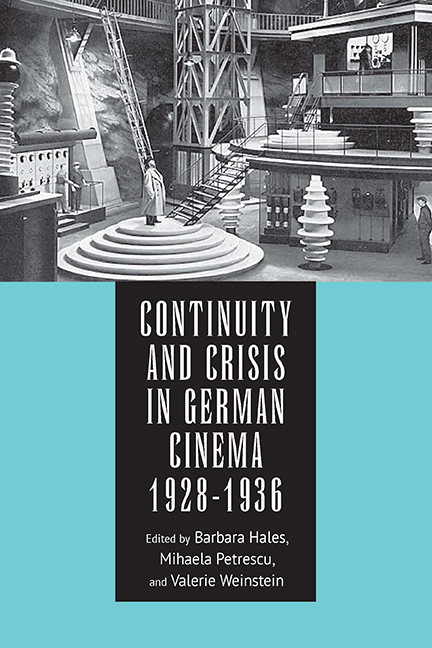Book contents
- Frontmatter
- Contents
- List of Illustrations
- Acknowledgments
- Introduction
- Part I Politics
- Part II The Economy
- Part III Concepts of Race and Ethnicity
- Part IV Genre Cinema
- Part V Making Cinema Stars
- Part VI Film Technologies
- Part VII German-International Film Relations
- Selected Bibliography
- Notes on the Contributors
- Index
Introduction
Published online by Cambridge University Press: 08 May 2021
- Frontmatter
- Contents
- List of Illustrations
- Acknowledgments
- Introduction
- Part I Politics
- Part II The Economy
- Part III Concepts of Race and Ethnicity
- Part IV Genre Cinema
- Part V Making Cinema Stars
- Part VI Film Technologies
- Part VII German-International Film Relations
- Selected Bibliography
- Notes on the Contributors
- Index
Summary
THE FOLLOWING COLLECTION OF ESSAYS investigates the continuities and discontinuities in German cinema before and after 1933, namely, during the transitional period of 1928 to 1936. Much of the scholarship on German cinema approaches the subject by assuming discrete historical periods defined by political regimes. Weimar and Third Reich film are thus often examined apart from one another, in spite of the continuities in both style and substance found in films made before and after 1933. Not only does this standard approach impede investigation of significant continuities, but it also obscures longer discursive genealogies and their social, political, and cinematic significance. The current volume serves as a corrective to this tendency by foregrounding comparisons of German cinematic works across the Weimar and Nazi periods.
Several scholars have challenged using the ascendancy of the National Socialists to power in 1933 as the basis for periodization of German cinema. Focusing on genre cinema, Klaus Kreimeier argues that the continuities and discontinuities in German film and film genres before and after 1933 pose serious problems for discrete periodization. For example, genre cinema does not exhibit a clear stylistic break between the Weimar and Nazi regimes, but rather more subtle differences. Focusing on modernist films, Thomas Elsaesser similarly challenges the 1933 break between Weimar and Nazi cinema, alternatively conceptualizing the period from 1930 to 1936 as a single filmic epoch in Germany, unified by the introduction of sound as well as common economic, technological, and geopolitical concerns. Building on Elsaesser's approach to the scholarship, the editors of this volume propose an earlier date of 1928, a year in which these various changes began to manifest.
Although differences in institutional circumstances before and after 1933 are obvious, the relationships among films made between 1928 and 1936 are complex and manifold. Within such rich complexity, we find particularly meaningful linkages in cinema's relationships to the political, economic, and social crises of these years. Although the construct of “crisis” posits a decisive break, as elaborated in the discussion that follows, such fantasies of rupture, disruption, and renewal persist throughout the period in question, accompanying and sometimes masking an array of stylistic, ideological, and institutional associations.
- Type
- Chapter
- Information
- Continuity and Crisis in German Cinema, 1928-1936 , pp. 1 - 28Publisher: Boydell & BrewerPrint publication year: 2016



